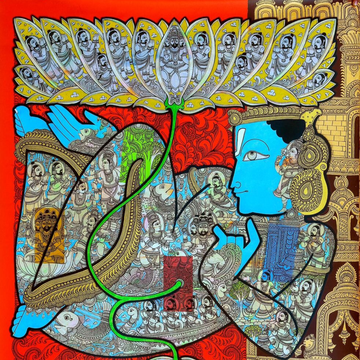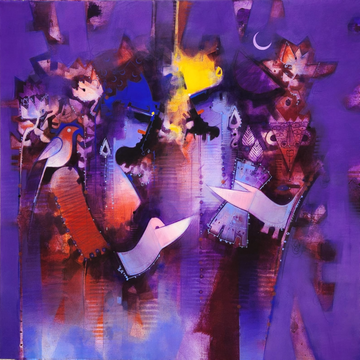Ramesh Gorjala Retelling the Captivating Tales of Ancient Indian History

At the first look, one might be drawn by the rustic colour palette, reds and yellows fusing into orange, followed by greens and blues on the canvas. But when the canvas catches the actual attention, one starts noticing the painstakingly drawn figures of Gods, Godesses, elephants, horses and fish, of men, women and flowers, all within the subject. All paintings might look similar, but each has a unique character, each telling a different story, some told, some untold, some heard, some unheard, but all imaginable and beautiful.
Art Inspiration and Muse
Born in 1979, in Kalahasti, the hometown of Srikalahasti Kalamkari style, Ramesh found his artistic inspiration in Indian mythology and ancient Indian history. He recreates Hindu Gods and Goddesses on his canvas, with his own unique and distinct interpretation. His use of vivid shades of red, orange and green blended with the stunning golden yellow, bring life to this astonishingly remarkable painting.

Growing up in a family of weavers, art was not foreign to Ramesh. While he saw his parents engaged in the delicate art of weaving, Ramesh started learning painting from his uncle, Balaji Theretham, who himself is a national award winning Kalamkari artist.
Kalamkari and the Art of Story Telling
Kalamkari is an ancient Indian art form in which artists narrate various Indian mythological stories on cotton fabric, paper or walls. This art could either be block-printed or hand-painted and uses natural dyes to colour the fabric. This detailed art is native to the Indian states of Andra Pradesh and Telangana. Among the two different schools of Kalamkari; Srikalahasti style and Machilipatnam style, Ramesh follows the Srikalahasti style. While Machilipatanm style is created with block printing, in Srikalahasti style the artist uses a Kalam or pen to freehand draw on a piece of fabric which makes it more unique and evolved.
Ramesh Gorjala received his BFA and MFA from Jawaharlal Nehru Technological University Hyderabad. This is where the artist learnt to part from vegetable dyes to colour his canvas and started portraying his art using acrylics on canvas and handwoven paper.

The artist starts with drawing the subject; a Hindu mythological character on a plain canvas. He then gradually fills the subject in, with numerous sketches and earthy hues and adorns them with various motifs. With an extremely busy and vibrant canvas, Ramesh’s art is not just a painting, it’s a story, an entire production.
Ramesh believes that the beauty of Hindu mythology entirely depends on the story telling. He says that as a storyteller, one’s art depends, not in the story but in the craft of telling the story. An writer should be able to engage the audience, make them eager to hear what happens next. Similarly, as an artist, it is extremely important that the onlookers should be engrossed in the painting he has created. How you present your art work is much important than what you present in it.

Contemporary Touch to the Ancient Art
Even though he was absolutely mesmerised by Indian mythology, the artist realised very early in his career that many artist have painted the images of Gods and Goddesses. But this realisation did not stop him from painting his favourite subjects, instead, he found an innovative and unique way to express his art on canvas. Ramesh took what he has been learning and seeing since his childhood; Kalamkari and incorporated it in his paintings, giving his paintings a distinct touch, a hint of intricacy to Indian mythology that not many artists have thought of. Ramesh Gorjala’s paintings blend the traditional art of Kalamkari along the contemporary touch of 21st century.
Though Ramesh found his muse in figures in Indian epics, his portrayal of these figurines is not as simple as those found in mythological books. They are much complex and deeper resonating with the complexities of the characters Themselves. Using the Kalamkari technique, Ramesh draws freehand line drawings inside the main icon, sketches that depict various stories and incidents from the character’s life.

For instance, the painting “Rama” narrates the incidence from Sita’s Swayamvara. It is believed that Ram took birth in the mortal world to destroy all that was evil. For this purpose, Ram picked up Dhanushya Ban or the bow and arrow. During Sita’s Swayamvara, the invitees were requested to string Shiva’s Dhanusya. None of the guests—including Ravan—could even move the Dhanusya, but when Lord Ram’s turn came, He not only picked up the Dhanushya to string it, He also broke it. This story has a great significance in Indian mythology, by breaking the Dhanushya, Ram broke the egos of arrogant Kshatriyas, indicated that Shiva and Vishnu were equal superpowers and informed Ravan that someone more powerful than him has taken birth on earth, to destroy his ill doings.

Similarly, the painting ‘Ganesha’ illustrate different stories from Ganesha’s life. Like His very many names, Ganesha has various forms, each telling a different story. Ganesha is known for his intelligence and wisdom, one can see Him dancing, playing flute, helping His devotees and patiently listening to His worshippers, thus using His intelligence and wisdom in different ways. The artist has used subtle hints of blue, yellow and orange to colour the intricate details and mixed tones of red, yellow and orange for the main subjects.
You might have heard that a picture says a thousand words, Ramesh with his absolutely stunning artwork, takes the phrase to the next level.













